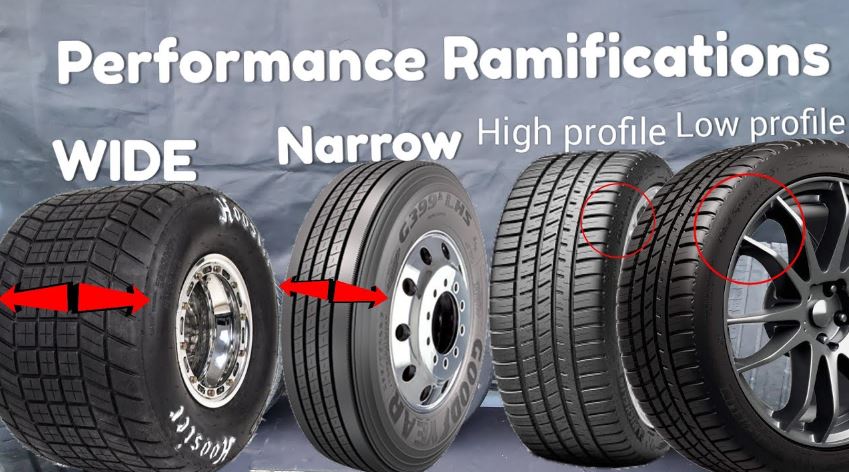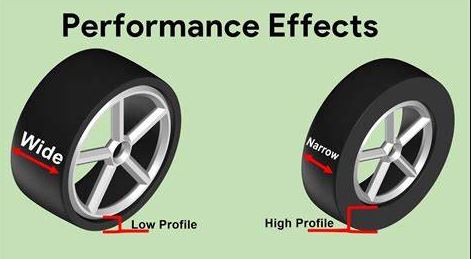Low Profile Tires:
Low profile tires are characterized by their shorter sidewalls, which contribute to a wider tire tread and a more aggressive, sporty appearance.
Advantages of Low Profile tires:
These tires offer several performance advantages:
- Improved Handling: The reduced sidewall flex allows for more precise steering response and enhanced cornering capabilities. This makes them popular among sports car enthusiasts who prioritize agility and responsiveness.
- Enhanced Stability: The shorter side walls result in less sidewall flex during high-speed maneuvers, providing greater stability and control, especially during hard cornering or abrupt lane changes.
- Better Aesthetics: Low profile tires are often chosen for their sleek and modern appearance, adding a touch of style to the vehicle’s overall design.
Drawbacks of Low Profile Tires:
- Reduced Comfort: The shorter side walls offer less cushioning from road imperfections, resulting in a harsher ride quality and increased susceptibility to impact damage, such as potholes or debris.
- Increased Vulnerability: Due to their lower profile, low profile tires are more prone to damage from curbs, road hazards, and rough terrain. They may also be more susceptible to sidewall damage and punctures.
High Profile Tires:
High profile tires feature taller sidewalls, providing more cushioning and a smoother ride.
Advantages of High Profile Tires:
They offer the following benefits:
- Comfortable Ride: The taller sidewalls absorb more shocks and vibrations from uneven road surfaces, resulting in a smoother and more comfortable driving experience. This makes them suitable for daily commuting and long-distance travel.
- Enhanced Durability: The increased sidewall height provides added protection against damage from potholes, curbs, and other road hazards. High profile tires are less prone to sidewall damage and punctures compared to their low profile counterparts.
- Versatility: High profile tires are well-suited for a wide range of vehicles, including sedans, SUVs, trucks, and off-road vehicles. They offer a balance of comfort, durability, and all-terrain performance.
Drawback and limitations of High Profile Tires:
- Reduced Handling: The taller sidewalls result in more sidewall flex during cornering and high-speed maneuvers, leading to decreased responsiveness and agility compared to low profile tires. This can impact overall handling and performance, particularly in sports-oriented driving scenarios.
- Aesthetic Considerations: Some drivers prefer the sportier appearance of low profile tires and may find high profile tires less visually appealing. The taller sidewalls can give the vehicle a more traditional or conservative look, which may not appeal to all enthusiasts.

Wide and Narrow Tires
Wide Tires & Their Advantages:
Wide tires feature a broader tread width, offering several performance advantages:
- Enhanced Traction: The larger contact patch provides increased grip and traction, particularly during acceleration, braking, and cornering. This improves overall vehicle stability and control, especially in high-performance driving conditions.
- Improved Handling: Wide tires contribute to more responsive steering and better cornering capabilities, allowing the vehicle to maintain its line through turns with greater precision and confidence.
- Enhanced Appearance: Wide tires can give the vehicle a more aggressive and muscular stance, enhancing its visual appeal and conveying a sense of performance and athleticism.
Disadvantages & drawbacks of wide Tires:
- Increased Rolling Resistance: The larger contact patch and increased tread width can result in higher rolling resistance, which can negatively impact fuel efficiency and overall vehicle performance, particularly at higher speeds.
- Reduced Aquaplaning Resistance: Wide tires may be more prone to aquaplaning (hydroplaning) in wet or rainy conditions due to their larger surface area and reduced ability to channel water away from the tread. This can affect traction and handling on wet roads.
Narrow Tires & Advantages:
Narrow tires have a narrower tread width, offering the following benefits:
- Improved Fuel Efficiency: Narrow tires typically have lower rolling resistance compared to wider tires, resulting in improved fuel economy and reduced CO2 emissions. This makes them a preferred choice for eco-friendly and fuel-efficient vehicles.
- Better Snow Traction: Narrow tires can provide better traction and grip on snow-covered or icy roads, as they exert higher pressure on the contact patch, allowing the tread to bite into the snow and maintain traction.
- Reduced Wind Resistance: The narrower profile of these tires reduces aerodynamic drag, resulting in improved highway fuel efficiency and reduced wind noise at higher speeds.
Disadvantages & limitations of Narrow Tires:
- Reduced Dry Traction: Narrow tires may have less surface area in contact with the road, resulting in reduced grip and traction, particularly during aggressive acceleration, cornering, or braking maneuvers.
- Limited Aesthetic Appeal: Some drivers may find narrow tires less visually appealing, as they lack the aggressive stance and muscular appearance associated with wider tires. This can be a subjective consideration based on individual preferences and aesthetic tastes.
Combined Effects on Performance
When considering both tire profile and width, it’s essential to strike a balance between performance, comfort, durability, and fuel efficiency based on the specific requirements of the vehicle and the driver’s preferences. Factors such as driving style, road conditions, climate, and intended use should all be taken into account when selecting the most suitable tires for a vehicle.
For sports cars or performance-oriented vehicles, low profile tires with a wider tread width may offer the best combination of agility, responsiveness, and grip, albeit with some compromises in ride comfort and fuel efficiency. On the other hand, for daily commuters or vehicles used in adverse weather conditions, high profile tires with narrower tread widths may provide a better balance of comfort, durability, and traction, albeit with some trade-offs in handling and aesthetics.
Ultimately, the optimal tire choice will depend on a careful evaluation of these factors and a consideration of the driver’s priorities and preferences. By understanding the effects of tire profile and width on vehicle performance, drivers can make informed decisions to enhance their driving experience and maximize the capabilities of their vehicles.

